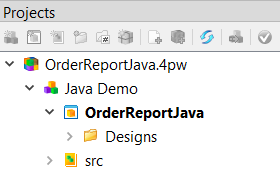Using the OrderReport demo
The OrderReport demo contains examples to show how the components of a report application fit together. Study these examples to learn how to build your own report design documents and report programs.
When Genero Studio launches, the Welcome Page lists the demo projects. Select one of the projects starting with "OrderReport" ( for example, OrderReportJava) to open the OrderReport demo project in Genero Studio.

The OrderReport demo project consists of:
- Application and form files, created using the Business Application Modeler or hand-coded.
- A set of report definition files, created with the Genero Report Designer.
- The data schema for the database used with the demo reports.
Note: The files can be found on your system in Documents\My Genero Report Writer
Files\samples\Reports.
The available reports are listed in Table 1.
| Report Name | Description | See Also |
|---|---|---|
| CategoryChart* | Several examples showing a category chart, or a chart that is grouped by two fields. These examples show how different charts can be produced from the same data. | Category charts |
| Dashboard report | A report displaying a dashboard that includes two business graphs and a table. It demonstrates business graphs and pivot tables. | Working with business graphs, Working with pivot tables |
| Dynamic Pivot Table | A report that allows you to select which fields to use as dimensions (for grouping) and which fields to include as measures. Generates a table of user-selected measures, grouped by user-selected dimensions. | Sample pivot table reports |
| Fancy Pivot Order List | A report displaying an order list grouped by countries and product lines. It uses the Grouped List with Totals template. It demonstrates regrouping, aggregations, and running totals. | Create and manage report templates, Report schema transformations |
| Generic List | Generic list report that allows you to select the fields to include. Generic reports are created at runtime and do not have a report design document. | Expand a template at runtime |
| Grouped Table Demo | A report in table format. This report shows a table with several header and body rows. | Table |
| List Demo | A report in list format that includes images, totals, and conditional text coloring. This report provides two examples of RTL expressions that control the font color and the "thumbs-up/thumbs-down" image at runtime, based on a field value. | Change the display based on a condition |
| MapChart* | Several examples showing a map chart, or a chart that is grouped by one field. These examples show how different charts can be produced from the same data. | Map charts |
| OrderLabels | A report consisting of pages of mailing labels for customers. It demonstrates the independence of the label design from the layout of the physical labels on the paper. | Design labels |
| OrderList | A report showing a text-based list, based on the list template. It illustrates the use for layout-dependent references. | Print a layout-dependent reference (Info Nodes) |
| OrderReport | A report detailing a customer order. This report illustrates the use of different page headers and footers on each page, and includes an OMR Bar Code. | Add headers and footers to a report |
| OrderStock | A report displaying stock information, including a code-39 bar code. This report illustrates the use of attachment and positioning rules, and shows you how to design a report onto a form or pre-printed paper using a background image. | Design documents for pre-printed forms |
| PivotOrderList | A report displaying revenue disribution by customer in a pivot order list. It demonstrates regrouping and aggregations. | Report schema transformations |
| RevenueAnalysis | A report that analyzes the revenue by area, category, and customer. It demonstrates duplication of data. | Report schema transformations |
| StaticPivotTable | A table of customer data, grouped by customers and orders. | Sample pivot table reports |
| TableDemo | A report in table format. This report shows a simple usage of a table. It also shows how to hide values that occur more than once. | Table, Hide repeated values |
To view these reports, run the Reports demo.